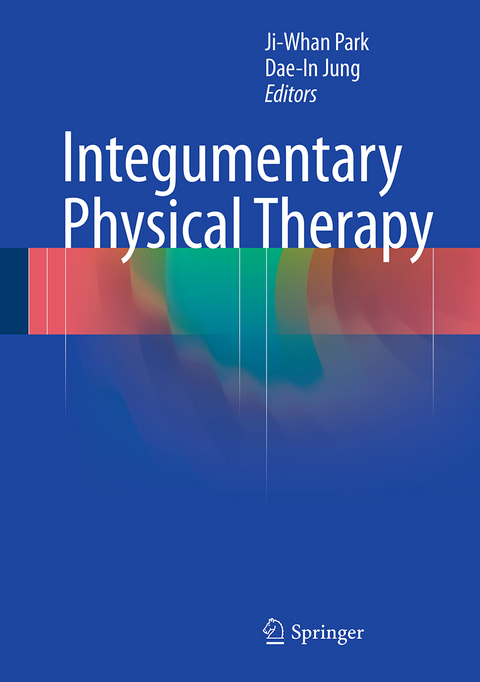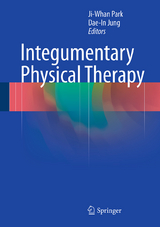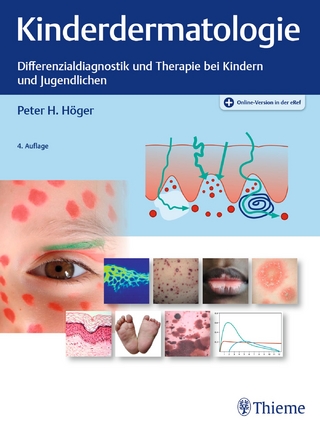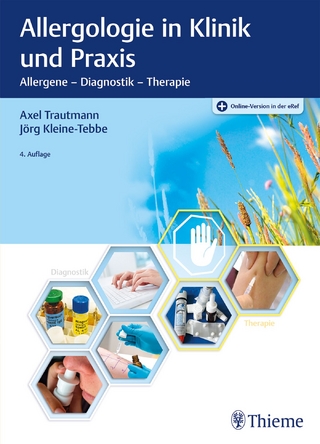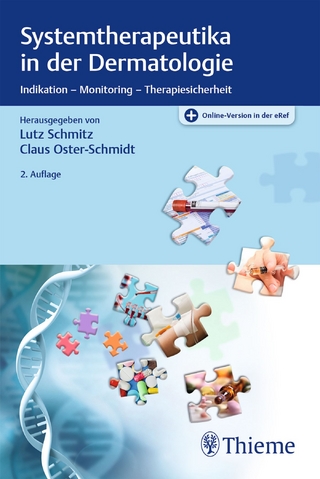Integumentary Physical Therapy
Springer Berlin (Verlag)
978-3-662-47379-5 (ISBN)
Ji-Whan Park is professor in Physical Therapy at Daejeon Health Sciences College. Dae-In Jung is professor in Physical Therapy at Gwangju Health University.
lt;p>01 Outline of IntegumentarySystem.- 1. Anatomical Structure of Integumentary System.- 1) Epidermis.- 2)Dermis.- 3) Subcutaneous Tissue.- 4) Appendages of the Skin or Skin Appendage.-2. Cutaneous Sensation and Neurarchy.- 1) Cutaneous Sensation.- 2) CutaneousNerve.- 3) Sensory Pathway.- Characteristic of Integumentary System.- 1.Type ofIntegumentary System.- 1) Classification of General Integumentary System Type.-2. Pathology and Recovery of Integumentary System Injury.- 1) Wound HealingMechanism.- 3. Skin Aging.- 1) Classification of Skin Aging.- 2) Cause of SkinAging.- 3) Age related Dermal Change Skin Change.- 4) Functional Change ofGeroderma.- 4. Skin Histopathology.- 1) Change of Epidermis.- 2) Change ofDermoepidermal Junction.- 3) Change of Dermis.- 4) Neoplasm of Melanocyte.- 5)Panniculitis.- Evaluation of Integumentary System.- 1. General CutaneousSymptom and Sign.- 1) Cutaneous Symptom.- 2) Cutaneous Sign.- 2. CutaneousSymptom.- 1) Pruritus.- 2) Eczema.- 3) Erythroderma.- 4) Hives or Urticaria.-5) Ganglion.- 6) Blood Vessel Lesion.- 7) Blush or Flush.- 8) Vesicle andBlister.- 9) Hypertrichosis and Hirsutism.- 10) Acanthosis Nigricans.- 11)Acquired Ichthyosis.- 3. Dermatological Examination Method.- 1) GeneralDiagnosis.- 2) Physical Examination.- 3) Examination using Diagnosis AssistDevice.- 4) Microbiologic Test.- 5) Skin Biopsy.- 6) Immunofluorescent Test.-7) Electron Microscopy.- 8) Skin Reaction Test.- 9) Oral Provocation Test.- 4.Examination and Evaluation of Physical Therapy.- 1) Examination.- ProblemSolving.- 02 Wound.- 1. Outline.- 2. Cause.- 1) Cutting.- 2) Tension.- 3)Compression.- 3. Classification.- 1) Partial Lamella Wound.- 2) CompleteLamella Wound.- 3) Other Classification.- 4. Symptom and Complication.- 1)Wound Infection.- 2) Suture Mark.- 3) Keloid and Hypertrophic Scarring.- 5.Examination and Evaluation.- 1) Initial Evaluation of Wound.- 2) Test toWound.- 3) Test around Wound.- Intervention.- 1. Intervention.- 1) InterventionalApproach.- 2) Medical Treatment.- Physical Therapy Intervention.- 1)Therapeutic Exercise.- 2) Manual Therapy.- 3) Physical Agent Therapy.- 3. Preventionand Management.- 1) Prevention.- 2) Management.- 3) Patient/GuardianEducation.- Advice for Physical Therapist.- Problem Solving.- 03 DecubitusUlcer.- 1. Outline.- 2. Cause.- 1) Pressure.- 2) Trauma Cutis.- 3) Chafing andSkin Friction.- 4) Loss of Cutaneous Sensation.- 5) Loss of Vasomotor.- 6)Humidity and Body Temperature.- 7) Nutritional Deficiency.- 3. Classification.-1) Compressive Decubitus Ulcer.- 2) Diabetic Decubitus Ulcer.- 4. Symptom.- 1)Decubitus Ulcer according to the Posture.- 2) Advancing Stage of DecubitusUlcer.- 5. Examination and Evaluation.- 1) Evaluation of Decubitus Ulcer.- 2) RecordGuideline of Decubitus Ulcer.- 3) Evaluation Tool of Decubitus Ulcer.- 4)Peripheral Blood Vessel Circulation Examination.- Intervention.- 1.Intervention.- 1) Interventional Approach.- 2) Medical Treatment.- 2. PhysicalTherapy Intervention.- 1) Decubitus Ulcer Prevention Posture.- 2) TherapeuticExercise.- 3) Manual Therapy.- 4) Physical Agent Therapy.- 3. Prevention andManagement.- 1) Diabetic Decubitus Ulcer.- 2) Compressive Decubitus Ulcer.- 3)Management.- 4) Patient/Guardian Education.- Advice for Physical Therapist.-Problem Solving.- 04 Burn.- 1. Outline.- 2. Cause.- 1) Scalding Burn.- 2) FlameBurn.- 3) Electrical Burn.- 4) Chemical Burn.- 5) Contact Burn.- 6) InhalationBurn.- 3. Classification.- 1) First Degree Burn.- 2) Second Degree Burn.- 3)Third Degree Burn.- 4) Fourth Degree Burn.- 4. Evaluation.- 1) Rule of Nines.-2) Lund-Browder Formula.- 3) American Burn Association.- 5. Symptom.- 1)Pathophysiological Symptom according to Recovery Stage.- 2) Systematic Symptomof the Human Body.- 3) Systemic Symptom.- 6. Prognosis and Complication.- 1)Prognosis.- 2) Complication.- Intervention.- 1. Intervention.- 1)Interventional Approach.- 2) Medical Treatment.- 3) Surgical Treatment.- 2.Physical Therapy Intervention.- 1) Therapy to Wound.- 2) Therapy to Edema.- 3)Take the Posture.- 4) Physical Agent Therapy.- 5) Therapeutic Exercise.- 6)Physical Therapy for Skin Graft.- 7) Scar Management by Burn.- 8) Orthosis.- 3.Prevention and Management.- 1) Prevention and Management.- 2) Patient/GuardianEducation.- Advice for Physical Therapist.- Problem Solving.- 05 Frostbite.- 1.Outline.- 2. Cause.- 3. Classification.- 1) Non-Frozen Injury.- 2) FreezeInjury.- 3) Classification according to the Grade of Frostbite Injury.- 4.Symptom.- 1) Clinical Symptom.- 2) Pathological Stage of Frostbite.- 5.Examination and Evaluation.- Intervention.- 1. Intervention.- 1) InterventionalApproach.- 2) Medical Treatment.- 2. Physical Therapy Intervention.- 1) Postureor Position.- 2) Therapeutic Exercise.- 3) Manual Therapy.- 4) Physical AgentTherapy.- 3. Prevention and Management.- 1) Prevention.- 2) Management.- 3) Patient/GuardianEducation.- Advice for Physical Therapist.- Problem Solving.- 06Photosensitivity Disorder.- 1. Outline.- 2. Cause.- 3. Classification.- 4.Symptom and Complication.- 1) Photoexacerbation Disorder.- 2) IdiopathicDisorder.- 3) Hereditary Disorder.- 4) Photosensitivity Disorder by ExtrinsicDrug.- 5) Metabolic Disorder.- 6) Neoplastic Disorder.- 5. Examination andEvaluation.- 1) Clinical Inspection.- 2) Final Examination.- 3)Histopathological Finding.- 4) Clinical Examination.- Intervention.- 1.Intervention.- 1) Interventional Approach.- 2) Medical Treatment.- 2. PhysicalTherapy Intervention.- 1) Physical Agent Therapy.- 3. Prevention andManagement.- 1) Prevention.- 2) Management.- 4. Patient and GuardianEducation.- Advice for Physical Therapist.- Problem Solving.- 07 InflammatorySkin Disease.- 1. Outline.- 1) Atopic Dermatitis.- 2) Contact Dermatitis.- 2.Cause.- 1) Atopic Dermatitis.- 2) Contact Dermatitis.- 3. Classification.- 1)Atopic Dermatitis.- 2) Contact Dermatitis.- 4. Symptom and Complication.- 1)Atopic Dermatitis.- 2) Contact Dermatitis.- 5. Examination and Evaluation.- 1)Atopic Dermatitis.- 2) Contact Dermatitis.- Intervention.- 1. Intervention.- 1)Interventional Approach.- 2) Medical Treatment.- 2. Physical TherapyIntervention.- 1) Therapeutic Exercise.- 2) Physical Agent Therapy.- 3.Prevention and Management.- 1) Atopic Dermatitis.- 2) Contact Dermatitis.- 3)Patient/Guardian Education.- Fibromyalgia Syndrome.- 1. Outline.- 2. Cause.- 1)Loss of Sufficient Sleep.- 2) Abnormal Neurochemical Reaction.- 3) SympatheticNervous System Disorder.- 4) Factor of Local Tissue.- 3. Symptom.- 4. Examinationand Evaluation.- Intervention.- 1. Intervention.- 1) Interventional Approach.-2) Medical Treatment.- 2. Physical Therapy Intervention.- 1) TherapeuticExercise.- 2) Manual Therapy.- 3) Physical Agent Therapy.- 3. Prevention andManagement.- 1) Prevention and Management.- 2) Patient/Guardian Education.-Advice for Physical Therapist.- Problem Solving.- 08 Skin Cancer.- 1. Outline.-2. Cause.- 3. Classification.- 1) Squamous Cell Carcinoma.- 2) Basal CellCarcinoma.- 3) Malignant Melanoma.- 4) Actinic Keratosis.- 4. Symptom andComplication.- 1) Squamous Cell Carcinoma.- 2) Basal Cell Carcinoma.- 3)Malignant Melanoma.- 5. Examination and Evaluation.- 1) Diagnosis of SkinCancer.- 2) Stage of Skin Cancer.- Intervention.- 1. Intervention.- 1)Interventional Approach.- 2) Medical Treatment.- 2. Physical TherapyIntervention.- 1) Posture or Position.- 2) Therapeutic Exercise.- 3) ManualTherapy.- 4) Physical Agent Therapy.- 3. Prevention and Management.- 1)Prevention of Skin Cancer.- 2) Management of Skin Cancer.- 3) Patient/GuardianEducation.- Lymphedema.- 1. Outline.- 2. Cause.- 3. Classification.- 1) PrimaryLymphedema.- 2) Secondary Lymphedema.- 4. Symptom and Complication.- 5.Examination and Evaluation.- 1) Radiologic Examination.- 2) Physical TherapyExamination.- 3) Circumference Self Measurement of Tapeline.- 4) Skin EdemaVolume-meter Examination.- 5) using Body Composition Analyzer(Inbody).- 6)Prodromal Symptom Identification.- 7) Symptom and Severity Evaluation.-Intervention.- 1. Intervention.- 1) Interventional Approach.- 2) MedicalTreatment.- 2. Physical Therapy Intervention.- 1) Posture or Position.- 2)Therapeutic Exercise.- 3) Manual Therapy.- 4) Skin Care.- 5) Physical AgentTherapy.- 3. Prevention and Management.- 1) Prevention of Lymphedema.- 2) Managementof Lymphedema.- 3) Patient/Guardian Education.- Advice for Physical Therapist.-Problem Solving.- 09 Obesity.- 1. Outline.- 2. Cause.- 1) Environment Factor.-2) Genetic and Congenital Cause.- 3) Neurological and Endocrine SystemDisorder.- 4) Drug.- 5) Psychological Factor.- 3. Classification.- 1)Classification by Cause of Obesity.- 2) Classification according to AdipocyteNumber and Size.- 3) Classification according to Distribution in Vivo ofAdipose Tissue.- 4) Classification according to Time of Obesity Onset.- 4.Symptom and Complication.- 1) Symptom of Obesity.- 2) Complication of Obesity.-5. Examination and Evaluation.- 1) Method using Weight Length Index.- 2)Evaluation Method at Fat Distribution.- 3) Other Body Fat Mass Measurement.-Intervention.- 1. Intervention.- 1) Interventional Approach.- 2) MedicalTreatment.- 2. Physical Therapy Intervention.- 1) Therapeutic Exercise.- 2)Manual Therapy.- 3) Physical Agent Therapy.- 3. Prevention and Management.- 1)Prevention.- 2) Management.- 3) Patient/Guardian Education.- Advice forPhysical Therapist.- Problem Solving.- 10 Other Skin Disorder(Psoriasis, HerpesZoster, Tinea Pedis, Vitiligo).- Psoriasis.- 1. Outline.- 2. Cause.- 3.Classification.- 1) Plaque Psoriasis.- 2) Guttate Psoriasis.- 3) InversePsoriasis.- 4) Exfoliative Psoriasis.- 5) Pustular Psoriasis.- 6) PsoriaticArthritis.- 7) Scalp Psoriasis.- 8) Fingernail and Toenail Psoriasis.- 4.Symptom and Complication.- 5. Examination and Evaluation.- Intervention.- 1.Intervention.- 1) Interventional Approach.- 2) Medical Treatment.- 2. PhysicalTherapy Intervention.- 1) Posture or Position.- 2) Therapeutic Exercise.- 3)Manual Therapy.- 4) Physical Agent Therapy.- 3. Prevention and Management.- 1)Prevention.- 2) Management.- 3) Patient/Guardian Education.- Herpes Zoster.- 1.Outline.- 2. Cause.- 3. Symptom and Complication.- 1) General Symptom.- 2) Partof Origin.- 3) Pain.- 4) Motor Disturbance or Motor Disorder.- 4. Examinationand Evaluation.- Intervention.- 1. Intervention.- 1) Interventional Approach.-2) Medical Treatment.- 2. Physical Therapy Intervention.- 1) Posture orPosition.- 2) Therapeutic Exercise.- 3) Manual Therapy.- 4) Physical AgentTherapy.- 3. Prevention and Management.- 1) Prevention.- 2) Management.- 3)Patient/Guardian Education.- Tinea Pedis.- 1. Outline.- 2. Cause.- 3. Symptomand Complication.- 4. Examination and Evaluation.- 1) Direct Smear Test.- 2)Fungal Culture Test.- Intervention.- 1. Intervention.- 1) InterventionalApproach.- 2) Medical Treatment.- 2. Physical Therapy Intervention.- 1) Postureor Position.- 2) Therapeutic Exercise.- 3) Manual Therapy.- 4) Physical AgentTherapy.- 3. Prevention and Management.- 1) Prevention.- 2) Management.- 3)Patient/Guardian Education.- Vitiligo.- 1. Outline.- 2. Cause.- 1) ImmuneTheory.- 2) Nerve Liquid Theory.- 3) Melanocyte Self Destruction Theory.- 3.Symptom and Complication.- 4. Examination and Evaluation.- Intervention.- 1.Intervention.- 1) Interventional Approach.- 2) Medical Treatment.- 2. PhysicalTherapy Intervention.- 1) Posture or Position.- 2) Therapeutic Exercise.- 3)Manual Therapy.- 4) Physical Agent Therapy.- 3. Prevention and Management.- 1)Prevention.- 2) Management.- 3) Patient/Guardian Education.- Advice forPhysical Therapist.- Problem Solving.
| Erscheint lt. Verlag | 28.9.2016 |
|---|---|
| Zusatzinfo | VII, 246 p. 234 illus., 226 illus. in color. |
| Verlagsort | Berlin |
| Sprache | englisch |
| Maße | 178 x 254 mm |
| Themenwelt | Medizin / Pharmazie ► Medizinische Fachgebiete ► Dermatologie |
| Medizin / Pharmazie ► Pflege | |
| Medizin / Pharmazie ► Physiotherapie / Ergotherapie ► Rehabilitation | |
| Schlagworte | Optimal Therapeutic Results • physical therapy • Rehabilitation • rehabilitation psychology • Skin Ailments • Therapeutic Exercise |
| ISBN-10 | 3-662-47379-8 / 3662473798 |
| ISBN-13 | 978-3-662-47379-5 / 9783662473795 |
| Zustand | Neuware |
| Haben Sie eine Frage zum Produkt? |
aus dem Bereich
